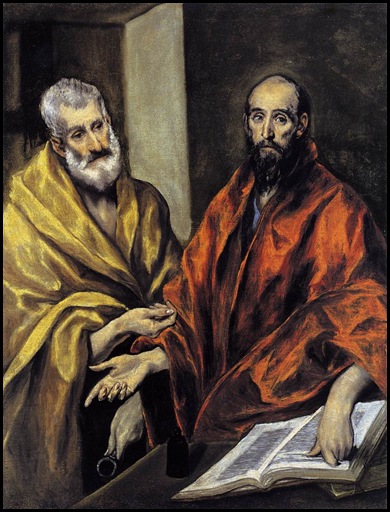What terribly odd Feasts, Peter and Paul who contended against one another sharing the same day and bracketing the Week of Prayer for Christian Unity. They simply did not get on. Galatians records the end of one of their fights when to his face Paul accuses Peter of hypocrisy, inconsistency, and cowardice. And it was not as though they did not get along because they were too much alike. Peter was a figure of stability, holding to the centre: conservative, sceptical of innovation, and a leader of Jewish Christianity in Jerusalem where it had all started. Paul was almost the complete opposite, working out on the fringes, radical in his message of discipleship and concentrated on making new converts from the Gentiles-the outsiders. Yet in the end they witnessed together, tradition teaching that they both died on the same day under the persecution of the Emperor Nero (although I am aware of the reality of the later translation of the relics to safety outside the city on this Roman civic holiday). So separated in life by deep theological division they are united in their deaths in witness to the same Christ.
By commemorating these two apostles together on the same day and keeping the Feast of the Confession of Saint Peter and the Conversion of Saint Paul to begin and end the Week of Prayer for Christian Unity the church reminds us that in the end we all serve one Master, one Lord. What matters as we work out our salvation ‘in fear and trembling’ is not our disagreements, our controversies but rather that we stay together whilst we do it. We are knitted together into one fellowship and one great mission to the world. If Peter and Paul, of all people, can become a symbol of unity then how silly our own divisions seem in comparison. The question at stake for these two was whether gentiles could be followers of Christ, members of his church – how petty, even disrespectful, are our threats to sever communion with one another over issues of human sexuality and equality of gender.
If that were the end of their story then all would be well. But there is another aspect of the coupling of Peter and Paul which is not so edifying. If in dying the two were united together in a common witness, then the churches treatment of them after death remains a great and troubling mystery. The Petrine Doctrine (based on a Greek pun) led the Emperor Constantine to build a vast church on the site of Peter’s Tomb. Later this would be rebuilt as the first church of Christendom. It is a place of pomp and ceremony which ‘would make Solomon blush’. The emphasis on Peter being the first Bishop of Rome which started under Damasus I in the second century has led to a monarchical episcopacy which has centralised religious authority unlike any other religious institution the world has seen. From being a poor relation of the Greek speaking churches of the East the Latin Church, still intact after the expansion of Islam, became the centre of the Christian Faith. This authority is claimed through the succession of Peter himself (it is worth remembering that as Peter was the head of the Church of Antioch her Patriarch also claims succession from him). So there in the centre of Rome above his tomb is the Papal throne of St Peter and Michelangelo’s monumental edifice – a magnet that draws the faithful by the millions ever year.
Yet Paul, whose martyrdom in Rome is much better attested to, lies some two miles away outside the city in the middle of what was once malaria, infested swamp. San Paolo Fuori le Mura ‘St Paul’s Outside the Walls’. Although also first built under the Emperor Constantine its neglect has been a source of embarrassment for hundreds of years. It was one of the chief scandals about the Roman church leading up to the Reformation. Few people even today know it let alone flock to it as a major site of pilgrimage.
This disgraceful discrepancy of honour shown to the two apostles after their deaths has theological consequences that I could go on and on about. Let it suffice to say that the Abbot of St Paul’s outside the Walls, Father Edmund Power, dreams of a Papacy that will one day reclaim its Pauline Ministry to balance its Petrine one. Structures and canons always follow cahnges in practice. To put it another way - Peter always follows Paul. Foror those of you feeling smug about not being a Roman Catholic, I remind you that all Western based Episcopal systems share the same imbalance towards Monarchical Bishops and centralisation (can anyone say Anglican Covenant?). For those not of an Episcopal Church I remind yyou to never underestimate the tyrany of a committee!
I long for a church that has a balanced Pauline/ Petrine ministry that is not only authoritative, stable and orderly like that founded upon the ‘Rock’ but one also marked by ministry on the edge, to those whom most Christians cannot even imagine being acceptable in the current church, a ministry radical and wandering and free. Then perhaps, finally in death, equality will be returned to those two men who in their lives and in their deaths bore witness to the unity which they both have bequeathed to us. Let us pray for the spirit of Paul to guide the church of today so that, eventually, Peter will finally catch up.
The Venerable Edward Simonton OGS
Priest of the Oratory of the Good Shepherd



